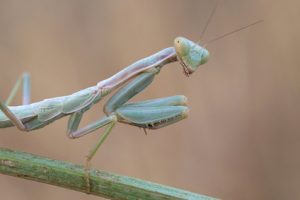The Mighty Mantis stands with Brad The Bugman and March Biological.
 The Praying Mantis is one of the larger insects, growing between 2 and 5 inches long. It is named for its prominent front legs, which are bent and held together at an angle that makes it look like it is praying. There are many different species of Praying Mantis and they tend to be named after the different areas where they are found, such as the European Mantis, Carolina Mantis, and the Chinese Mantis.
The Praying Mantis is one of the larger insects, growing between 2 and 5 inches long. It is named for its prominent front legs, which are bent and held together at an angle that makes it look like it is praying. There are many different species of Praying Mantis and they tend to be named after the different areas where they are found, such as the European Mantis, Carolina Mantis, and the Chinese Mantis.
Like all insects, the Praying Mantis has a head, thorax, and abdomen. It has large eyes on each side of its head and is the only insect that can turn its head 360 degrees. You will never be able to sneak up on a Mantis.
The Mantis uses the two antennae on its head for navigation. Once fully grown, a Praying Mantis will grow wings and fly.
It has six legs. The four back legs are used primarily for walking, while the front two, with their sharp spines, help the Mantis capture and hold prey.
The Praying Mantis can camouflage to hide from predators or sneak up on its prey. Different species vary in color from vivid green to dark brown.
The Praying Mantis is a meat eater, living off of other animals not plants. Good news for your garden! They love flies and crickets, but some larger Praying Mantis have been known to dine on small reptiles or birds. And although they sit can sit very still and seem slow, they are extremely fast when they move to attack their prey.
They live for a short time, Spring to Fall. The longest a Mantis might live is about 1 year. Maybe that is because the female often eats her mate and the siblings tend to dine on one another.
To learn more about Praying Mantis or for a fun school project visit www.marchbiological.com.
